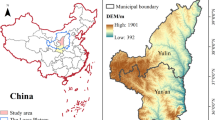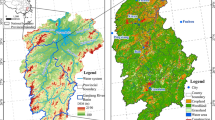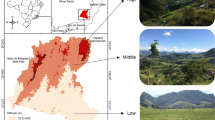Abstract
Context
Constructing a sustainable landscape pattern from the perspective of landscape sustainability is scientifically built on the clarification of the formation mechanisms of landscape services and their relationships. However, the trade-offs and synergies of landscape services have regional heterogeneity, and their influencing factors are largely unknown in polar ecosystem. The Qinghai–Tibet Plateau is a unique but fragile ecosystem, and its landscape services are vital components to the sustainability in this specific polar region.
Objectives
This study sought to understand the landscape service relationships, their dynamics and influencing factors, and achieve a sustainable landscape management in the Qinghai–Tibet Plateau.
Methods
In this work, we evaluated the spatiotemporal distribution and relationships of multiple landscape services including soil retention (SR), water yield (WY), habitat quality (HQ), crop supply (CS) and livestock supply (LS). We further identified temperature, elevation, population size, land use and land cover (LULC) as influencing factors on landscape services relationships within specific landscape gradients.
Results
Our results show that: (1) SR, WY and HQ decreased significantly from the southeast to the northwest. (2) Regulating services-supporting services are mainly identified as synergies, and CS–HQ and CS–LS are manifested as trade-offs. (3) Geophysical factors (temperature, altitude) have impact on the distribution of CS and the trade-off and synergistic dynamics of WY–HQ, increased population size enhances CS–HQ trade-offs, while between supporting and regulating services show trade-offs in high-coverage grassland and unused land.
Conclusions
The quantitative assessment of landscape services and relationships provides the basis for sustainable landscape management in the context of national policies and climate change.







Similar content being viewed by others
References
Ai J, Sun X, Feng L, Li Y, Zhu X (2015) Analyzing the spatial patterns and drivers of ecosystem services in rapidly urbanizing Taihu Lake Basin of China. Front Earth Sci 9(3):531–545
Arsenault J, Michel P, Berke O, Ravel A, Gosselin P (2013) How to choose geographical units in ecological studies: proposal and application to campylobacteriosis. Spatial Spatio-temporal Epidemiol 7:11–24
Bennett EM, Peterson GD, Gordon LJ (2010) Understanding relationships among multiple ecosystem services. Ecol Lett 12(12):1394–1404
Cademus R, Escobedo F, McLaughlin D, Abd-Elrahman A (2014) Analyzing trade-offs, synergies, and drivers among timber production, carbon sequestration, and water yield in Pinus elliotii& forests in southeastern USA. Forests 5(6):1409–1431
Cao JJ, Holden NM, Adamowski JF, Deo RC, Xu XY, Feng Q (2018) Can individual land ownership reduce grassland degradation and favor socioeconomic sustainability on the Qinghai–Tibetan Plateau? Environ Sci Policy 89:192–197
Cerretelli S, Poggio L, Gimona A, Yakob G, Boke S, Habte M, Coull M, Peressotti A, Black H (2018) Spatial assessment of land degradation through key ecosystem services: the role of globally available data. Sci Total Environ 628:539–555
Chan KM, Shaw MR, Cameron DR, Underwood EC, Daily GC (2006) Conservation planning for ecosystem services. PLoS Biol 4(11):e379
Chen D, Xu B, Yao T, Guo Z, Cui P, Chen F, Zhang R, Zhang X, Zhang Y, Fan J, Hou Z, Zhang T (2015) Assessment of past, present and future environmental changes on the Tibetan Plateau. Chin Sci Bull 60(32):3025–3035
Chen H, Zhu Q, Peng C, Wu N, Wang Y, Fang X, Gao Y, Zhu D, Yang G, Tian J, Kang X, Piao S, Ouyang H, Xiang W, Luo Z, Jiang H, Song X, Zhang Y, Yu G, Zhao X, Gong P, Yao T, Wu J (2013) The impacts of climate change and human activities on biogeochemical cycles on the Qinghai–Tibetan Plateau. Glob Change Biol 19(10):2940–2955
Cheng L, Huang T, Liu Y (2019) Analysis on evolution of ecosystem service value in Qinghai–Tibet Plateau based on improved value equivalent Factors from 1992 to 2015. Res Soil Water Conserv 39(05):242–248 + 345–346 (in Chinese)
Chiang L-C, Lin Y-P, Huang T, Schmeller DS, Verburg PH, Liu Y-L, Ding T-S (2014) Simulation of ecosystem service responses to multiple disturbances from an earthquake and several typhoons. Landsc Urban Plan 122:41–55
Chisholm RA (2010) Trade-offs between ecosystem services: water and carbon in a biodiversity hotspot. Ecol Econ 69(10):1973–1987
Cord AF, Bartkowski B, Beckmann M, Dittrich A, Hermans-Neumann K, Kaim A, Lienhoop N, Locher-Krause K, Priess J, Schröter-Schlaack C (2017) Towards systematic analyses of ecosystem service trade-offs and synergies: main concepts, methods and the road ahead. Ecosyst Serv 28:264–272
Cui F, Tang H, Zhang Q, Wang B, Dai L (2019) Integrating ecosystem services supply and demand into optimized management at different scales: a case study in Hulunbuir, China. Ecosyst Serv 39:100984
Cumming GS, Olsson P, Chapin FS III, Holling CS (2013) Resilience, experimentation, and scale mismatches in social–ecological landscapes. Landsc Ecol 28(6):1139–1150
Dade MC, Mitchell MGE, McAlpine CA, Rhodes JR (2019) Assessing ecosystem service trade-offs and synergies: the need for a more mechanistic approach. Ambio 48(10):1116–1128
Dai E, Wang X, Zhu J, Gao J (2015) Progress and perspective on ecosystem services trade-offs. Adv Earth Sci 30(11):50–55
Dobbs C, Nitschke CR, Kendal D (2014) Global drivers and tradeoffs of three urban vegetation ecosystem services. PLoS ONE. https://doi.org/10.1371/journal.pone.0113000
Egoh B, Reyers B, Rouget M, Bode M, Richardson DM (2009) Spatial congruence between biodiversity and ecosystem services in South Africa. Biol Conserv 142(3):553–562
Egoh B, Reyers B, Rouget M, Richardson DM, Maitre DCL, Jaarsveld ASV (2008) Mapping ecosystem services for planning and management. Agric Ecosyst Environ 127(1):135–140
Eitelberg DA, van Vliet J, Doelrnan JC, Stehfest E, Verburg PH (2016) Demand for biodiversity protection and carbon storage as drivers of global land change scenarios. Glob Environ Change Hum Policy Dimens 40:101–111
Ellison D, Futter MN, Bishop K (2012) On the forest cover–water yield debate: from demand- to supply-side thinking. Glob Change Biol 18(3):806–820
Fan F, Liu Y, Chen J, Dong J (2020) Scenario-based ecological security patterns to indicate landscape sustainability: a case study on the Qinghai–Tibet Plateau. Landsc Ecol. https://doi.org/10.1007/s10980-020-01044-2
Fenta AA, Yasuda H, Shimizu K, Haregeweyn N, Kawai T, Sultan D, Ebabu K, Belay AS (2017) Spatial distribution and temporal trends of rainfall and erosivity in the Eastern Africa region. Hydrol Process 31(25):4555–4567
Ferrari M, Geneletti D (2014) Mapping and assessing multiple ecosystem services in an alpine region: a study in Trentino, Italy. Speculum 122(51):773
Ferrari M, Geneletti D, Cayuela L, Orsi F, Benayas JMR (2017) Analysis of bundles and drivers of change of multiple ecosystem services in an Alpine region. J Environ Assess Policy Manag 18(04):1650026
Field CB, Randerson JT, Malmström CM (1995) Global net primary production: combining ecology and remote sensing. Remote Sens Environ 51(1):74–88
Frazier AE, Bryan BA, Buyantuev A, Chen L, Echeverria C, Jia P, Liu L, Li Q, Ouyang Z, Wu J, Xiang W-N, Yang J, Yang L, Zhao S (2019) Ecological civilization: perspectives from landscape ecology and landscape sustainability science. Landsc Ecol 34(1):1–8
Ge S, Hallema D, Asbjornsen H (2017) Ecohydrological processes and ecosystem services in the Anthropocene: a review. Ecol Process 6(1):35
Godde CM, Garnett T, Thornton PK, Ash AJ, Herrero M (2018) Grazing systems expansion and intensification: drivers, dynamics, and trade-offs. Glob Food Secur Agric Policy Econ Environ 16:93–105
Howe C, Suich H, Vira B, Mace GM (2014) Creating win-wins from trade-offs? Ecosystem services for human well-being: a meta-analysis of ecosystem service trade-offs and synergies in the real world. Glob Environ Change 28:263–275
Jaligot R, Chenal J (2019) Stakeholders’ perspectives to support the integration of ecosystem services in spatial planning in Switzerland. Environments 6(8):88
Jiang Y, Li S, Shen D, Chen W (2012) Climate change and its impact on the regional environment in the source regions of the Yangtze, Yellow and Lantsang Rivers in Qinghai–Tibetan Plateau during 1971–2008. J Mt Sci 30(4):461–469
Jin X, Jiang P, Ma D, Li M (2019) Land system evolution of Qinghai–Tibetan Plateau under various development strategies. Appl Geogr 104:1–9
Kong L, Hua Z, Yi X, Ouyang Z, Huang B (2018) Mapping ecosystem service bundles to detect distinct types of multifunctionality within the diverse landscape of the Yangtze River Basin, China. Sustainability 10(3):857–873
Li L, Tietze DT, Fritz A, Lü Z, Bürgi M, Storch I (2018) Rewilding cultural landscape potentially puts both avian diversity and endemism at risk: a Tibetan Plateau case study. Biol Conserv 224:75–86
Liu Y, Li T, Zhao W, Wang S, Fu B (2019) Landscape functional zoning at a county level based on ecosystem services bundle: methods comparison and management indication. J Environ Manag 249:109315. https://doi.org/10.1016/j.jenvman.2019.109315
Lorilla R, Poirazidis K, Kalogirou S, Detsis V, Martinis A (2018) Assessment of the spatial dynamics and interactions among multiple ecosystem services to promote effective policy making across Mediterranean Island landscapes. Sustainability 10(9):3285–3313
Metzger MJ, Rounsevell MDA, Acosta L, Leemans R, Schröter D (2006) The vulnerability of ecosystem services to land use change. Agric Ecosyst Environ 114(1):69–85
Michael Hoffman KK, Bunting G, Costanza J, Williams KJ (2016) Biodiversity Hotspots (version 2016.1). Zenodo. https://doi.org/10.5281/zenodo.3261807
Miehe G, Miehe S, Will M, Opgenoorth L, Duo L, Dorgeh T, Liu J (2008) An inventory of forest relicts in the pastures of Southern Tibet (Xizang A.R., China). Plant Ecol 194(2):157–177
Nieto-Romero M, Oteros-Rozas E, González JA, Martín-López B (2014) Exploring the knowledge landscape of ecosystem services assessments in Mediterranean agroecosystems: insights for future research. Environ Sci Policy 37(3):121–133
Pan T, Wu SH, Dai EF, Liu YJ (2013) Spatiotemporal variation of water source supply service in Three Rivers Source Area of China based on InVEST model. Chin J Appl Ecol 24(1):183–189 (in Chinese)
Pei Y, Zhang J (2004) China geography. Chinese Book Company, Beijing
Peng J, Chen X, Liu Y, Lu H, Hu X (2016) Spatial identification of multifunctional landscapes and associated influencing factors in the Beijing–Tianjin–Hebei region, China. Appl Geogr 74:170–181
Peng J, Hu X, Zhao M, Liu Y, Tian L (2017) Research progress on ecosystem service trade-offs: from cognition to decision-making. Acta Geogr Sin 72(6):960–973
Piao S, Zhang X, Wang T, Liang E, Wang S, Zhu J, Niu B (2019) Responses and feedback of the Tibetan Plateau’s alpine ecosystem to climate change. Chin Sci Bull 64(27):2842–2855
Qiu J, Carpenter SR, Booth EG, Motew M, Zipper SC, Kucharik CJ, Loheide SP, Turner AG II (2018) Understanding relationships among ecosystem services across spatial scales and over time. Environ Res Lett. https://doi.org/10.1088/1748-9326/aabb87
Renard KG (1997) Predicting soil erosion by water: a guide to conservation planning with the Revised Universal Soil Loss Equation (RUSLE). United States Government Printing
Rodriguez JP, Beard TD Jr, Bennett EM, Cumming GS, Cork SJ, Agard J, Dobson AP, Peterson GD (2006) Trade-offs across space, time, and ecosystem services. Ecol Soc 11(1):28
Samhouri JF, Levin PS, Ainsworth CH (2010) Identifying thresholds for ecosystem-based management. PLoS ONE 5(1):e8907
Sanderson MA, Archer D, Hendrickson J, Kronberg S, Liebig M, Nichols K, Schmer M, Tanaka D, Aguilar J (2013) Diversification and ecosystem services for conservation agriculture: outcomes from pastures and integrated crop–livestock systems (vol 28, pg 129, 2013). Renew Agric Food Syst 28(2):194–194
Scherr SJ, Mcneely JA (2008) Biodiversity conservation and agricultural sustainability: towards a new paradigm of ‘ecoagriculture’ landscapes. Philos Trans R Soc Lond B 363(1491):477–494
Sharp R, Douglass J, Wolny S, Arkema K, Bernhardt J, Bierbower W, Chaumont N, Denu D, Fisher D, Glowinski K, Griffin R, Guannel G, Guerry A, Johnson J, Hamel P, Kennedy C, Kim CK, Lacayo M, Lonsdorf E, Mandle L, Rogers L, Silver J, Toft J, Verutes G, Vogl AL, Wood S, Wyatt K (eds) (2020) InVEST 3.8.6.post10 + ug.gd5fbb6e User’s Guide
Shui Y, Lu H, Wang H, Yan Y, Wu G (2018) Assessment of habitat quality on the basis of land cover and NDVI changes in Lhasa River Basin. Acta Ecol Sin 38(24):8946–8954
Spake R, Lasseur R, Crouzat E, Bullock JM, Lavorel S, Parks KE, Schaafsma M, Bennett EM, Maes J, Mulligan M (2017) Unpacking ecosystem service bundles: towards predictive mapping of synergies and trade-offs between ecosystem services. Glob Environ Change 47:37–50
Sun H, Zheng D, Yao T, Zhang Y (2012) Protection and construction of the National Ecological Security Shelter Zone on Tibetan Plateau. Acta Geogr Sin 67(1):3–12
Termorshuizen JW, Opdam P (2009) Landscape services as a bridge between landscape ecology and sustainable development. Landsc Ecol 24(8):1037–1052
Terrado M, Sabater S, Chaplin-Kramer B, Mandle L, Ziv G, Acuña V (2016) Model development for the assessment of terrestrial and aquatic habitat quality in conservation planning. Sci Total Environ 540:63–70
Tomscha S, Gergel S (2016) Ecosystem service trade-offs and synergies misunderstood without landscape history. Ecol Soc 21(1):43
Turner KG, Odgaard MV, Bocher PK, Dalgaard T, Svenning J-C (2014) Bundling ecosystem services in Denmark: trade-offs and synergies in a cultural landscape. Landsc Urban Plan 125:89–104
Wang Y, Dai E, Ma L, Yin L (2020) Spatiotemporal and influencing factors analysis of water yield in the Hengduan Mountain region. J Nat Resour 35(2):371–386
Wang Y, Ren Z, Ma PP, Wang ZM, Niu DC, Fu H, Elser JJ (2020) Effects of grassland degradation on ecological stoichiometry of soil ecosystems on the Qinghai–Tibet Plateau. Sci Total Environ 722:10
Weng N, Liu K, Wang J (2014) A study of relationship between spatial vegetation pattern and terrain factors based on GIS techniques. Bull Soil Water Conserv 34(1):232–236
Williams JR (1990) The erosion-productivity impact calculator (EPIC) model: a case history. Philos Trans R Soc Lond B 329(1255):421–428
Wischmeier WH, Smith DD (1958) Rainfall energy and its relationship to soil loss. Trans Am Geophys Union 39(2):285–291
Wu J (2007) Landscape ecology: pattern, process scale and hierarchy. Higher Education Press, Beijing
Wu J (2013) Landscape sustainability science: ecosystem services and human well-being in changing landscapes. Landsc Ecol 28(6):999–1023
Wu J (2019) Linking landscape, land system and design approaches to achieve sustainability. J Land Use Sci 14(2):173–189
Wu R (2016) China’s ecosystems: focus on biodiversity. Science 353(6300):657
Xiao Y, Xie G, An K (2003) The function and economic value of soil conservation of ecosystems in Qinghai–Tibet Plateau. Acta Ecol Sin 23(11):2367–2378
Xu J, Chen J, Liu Y, Fan F, Wei J (2020) Spatio-temporal differentiation of interaction of ecosystem services and regional responses in the “Belt and Road” area. Acta Ecol Sin 40(10):3258–3270
Xu W, Xiao Y, Zhang J, Yang W, Zhang L, Hull V, Wang Z, Zheng H, Liu J, Polasky S, Jiang L, Xiao Y, Shi X, Rao E, Lu F, Wang X, Daily GC, Ouyang Z (2017) Strengthening protected areas for biodiversity and ecosystem services in China. Proc Natl Acad Sci USA 114(7):1601–1606
Yan C, Fei Q, Lei J (2016) Effects of land use pattern change on regional scale habitat quality based on InVEST model—a case study in Beijing. Acta Sci Nat Univ Pekin 52(3):553–562
Yang S, Zhao W, Liu Y, Wang S, Wang J, Zhai R (2018) Influence of land use change on the ecosystem service trade-offs in the ecological restoration area: dynamics and scenarios in the Yanhe Watershed, China. Sci Total Environ 644:556–566
Yao T, Lu H, Yu Q, Feng W (2020) Potential evapotranspiration characteristic and its abrupt change across the Qinghai–Tibetan Plateau and its surrounding areas in the last 50 years. Prog Geogr 35(05):534–546
Yin L, Wang X, Zhang K, Xiao F, Cheng C, Zhang X (2019) Trade-offs and synergy between ecosystem services in National Barrier Zone. Geogr Res 38(9):2162–2172
Yu C, Zhang Y, Claus H, Zeng R, Zhang X, Wang J (2012) Ecological and environmental issues faced by a developing Tibet. Environ Sci Technol 46(4):1979–1980
Zhang X, Guo F, Zhai Z (2019b) China’s demographic future under the New Two-Child Policy. Popul Res Policy Rev 38(4):537–563
Zhang Y, Li B, Zheng D (2002) A discussion on the boundary and area of the Tibetan Plateau in China. Geogr Res 21(1):1–8
Zhang Y, Liu L, Wang Z, Bai W, Ding M, Wang X, Yan J, Xu E, Wu X, Zhang B, Liu Q, Zhao Z, Liu F, Zheng D (2019c) Spatial and temporal characteristics of land use and cover changes in the Tibetan Plateau. Chin Sci Bull Chin 64(27):2865–2875
Zhang Y, Qi W, Zhou C, Ding M, Liu L, Gao J, Bai W, Wang Z, Zheng D (2014) Spatial and temporal variability in the net primary production of alpine grassland on the Tibetan Plateau since 1982. J Geogr Sci 24(2):269–287
Zhang HB, Zhang F, Zhang GQ, Che T, Yan W, Ye M, Ma N (2019a) Ground-based evaluation of MODIS snow cover product V6 across China: implications for the selection of NDSI threshold. Sci Total Environ 651:2712–2726
Zheng D (2003) The formation environment and development of the Qinghai–Tibet Plateau. Hebei Science & Technology Press, Shijiazhuang
Zheng H, Li Y, Ouyang Z, Luo Y (2013) Progress and perspectives of ecosystem services management. Acta Ecol Sin 33(3):702–710
Zheng D, Zhao D (2017) Characteristics of natural environment of the Tibetan Plateau. Sci Technol Rev 35(6):13–22
Zheng D, Zhao D (2019) The high cold desert zone and a cold-arid core area of the Tibetan Plateau. Arid Zone Res 36(1):1–6
Zhuge H, Li X, Zhang X, Gao F, Xu D (2014) Identification and conservation assessment of suitable habitats for Tibetan antelope in the alpine desert, Qinghai–Tibet Plateau. Chin J Appl Ecol 25(12):3483–3490
Acknowledgements
This research was funded by the National Natural Science Foundation of China (41861134038), the Second Tibetan Plateau Scientific Expedition and Research Program, Grant No.2019QZKK0405, Norwegian Research Council (No. 286773), and the Fundamental Research Funds for the Central Universities.
Author information
Authors and Affiliations
Corresponding author
Additional information
Publisher's Note
Springer Nature remains neutral with regard to jurisdictional claims in published maps and institutional affiliations.
Electronic supplementary material
Below is the link to the electronic supplementary material.
Rights and permissions
About this article
Cite this article
Hou, Y., Zhao, W., Liu, Y. et al. Relationships of multiple landscape services and their influencing factors on the Qinghai–Tibet Plateau. Landscape Ecol 36, 1987–2005 (2021). https://doi.org/10.1007/s10980-020-01140-3
Received:
Accepted:
Published:
Issue Date:
DOI: https://doi.org/10.1007/s10980-020-01140-3




